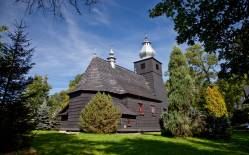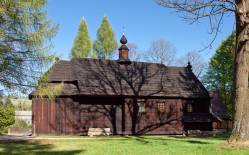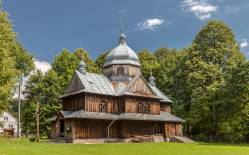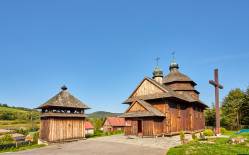On the right side of the road leading towards Ustrzyki Dolne, there is a church standing on a hill and bringing to mind churches encountered in Hutsulshchyna. The former Greek-Catholic tserkva of St. Nicholas is another example of Ukrainian historicism.
Its construction started shortly before the outbreak of WWII. Prior to that an older tserkva, built in 1732 or 1770, was demolished and the building materials were used in the new church. At the start of the war, when Hoszów was occupied by the Soviet army, the tserkva was covered with a thatched roof. It is said that later Germans stored ammunition here; the materials exploded and damaged the building. The construction was only completed in 1948, when the tserkva was covered with shingles. In 1951, after the enforced relocation of the local population, the church was used as a sheepfold and for other purposes. In 1971 the building was acquired by Roman Catholics, and transformed into a filial church of the Blessed Bronisława.
The three-part log church is oriented eastward, and is covered with wood planks. It has a layout of an equal-armed cross. It is topped with an octagonal dome supported on a drum. The chancel, enclosed in semi-hexagonal walls, is adjoined by two sacristies. A painting of Blessed Bronisława can be seen on the gable. Above the chancel, the side naves and the pritvor we can see turrets with pinnacles.
Inside you can see the clever structure of the drum and the dome, but there are no furnishings typical for tserkvas. No iconostasis was built before the deportation of the local people. No lush tserkva-style paintings can be admired here, because there was too little time for these to be created, either.
Next to the tserkva there is a modern bell stand. The bell was delivered by Felczyński Foundry in Przemyśl. At the back of the church there are remnants of the old graveyard with a few tombstones.
Photo: Krzysztof Zajączkowski
Gallery
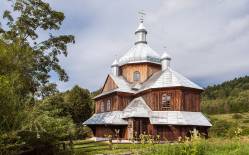
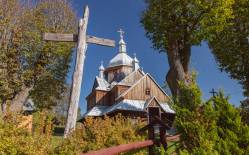
Recommended venues on the Trail



This website has been modernized with the financial support of the European Union under the Cross-Border Cooperation Programme Poland-Belarus-Ukraine 2014-2020. The responsibility for its content lies solely with the Podkarpackie Regional Tourism Board and cannot, in any case, be treated as a reflection of the position of the European Union, the Managing Authority, or the Joint Technical Secretariat of the Cross-Border Cooperation Programme Poland-Belarus-Ukraine 2014-2020.










